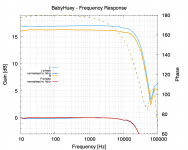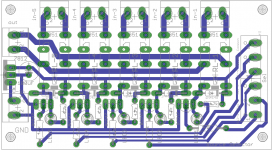A few more voltage / current measurements taken - I've updated the repo with these, an updated schematic and a power-on procedure: https://github.com/tristancollins/HiFi-BabyHuey
Supply voltages are:
B+ = 400V
V_pos = 16.4V to the source followers
V_neg = -127.5V to the CSSs
Currents:
I reduced the current in the driver CSS to 0.75mA per side.
The source followers have 1.5mA going through them, which is a bit lower than others have reported.
40mA going through the EL34s, but I might increase this to 50mA
No audible hum (and this is before I tweak the humdinger) with my head up against the speaker. Slight rectifier buzz through the tweeter but less than the DCPP.
The amp sounds great. Seems to have a bit more bass through my speakers than my DCPP gives. And, compared to the DCPP, it runs way cooler. I'll take a few more measurements over the next few days, starting with a check for any oscillations, then balancing the heaters, then Bode plots for frequency response and some square wave snapshots.
Supply voltages are:
B+ = 400V
V_pos = 16.4V to the source followers
V_neg = -127.5V to the CSSs
Currents:
I reduced the current in the driver CSS to 0.75mA per side.
The source followers have 1.5mA going through them, which is a bit lower than others have reported.
40mA going through the EL34s, but I might increase this to 50mA
No audible hum (and this is before I tweak the humdinger) with my head up against the speaker. Slight rectifier buzz through the tweeter but less than the DCPP.
The amp sounds great. Seems to have a bit more bass through my speakers than my DCPP gives. And, compared to the DCPP, it runs way cooler. I'll take a few more measurements over the next few days, starting with a check for any oscillations, then balancing the heaters, then Bode plots for frequency response and some square wave snapshots.
I ventured over to your Github folder and marveled at the professional job you have done with your documentation. Really a gift to anyone that wants to build a “one board” Baby Huey, and an example of how to document projects for the rest of us. Well done!
You are also doing the community a service by actually testing the Baby Huey performance thoroughly. While many built it, there had been few published performance tests. Thank you.
You are also doing the community a service by actually testing the Baby Huey performance thoroughly. While many built it, there had been few published performance tests. Thank you.
Many thanks for the kind words Francois. I hope others can take this approach and extend it - 6V6 model?I ventured over to your Github folder and marveled at the professional job you have done with your documentation. Really a gift to anyone that wants to build a “one board” Baby Huey, and an example of how to document projects for the rest of us. Well done!
You are also doing the community a service by actually testing the Baby Huey performance thoroughly. While many built it, there had been few published performance tests. Thank you.
I'll be intrigued by the measurements too: going from the DCPP (low distortion, "hi fi", accurate etc) to the Baby Huey. So far I'm really enjoying the amp - it takes the place of my DCPP and is the main amp for my TV / music sources, so many hours of use ahead. The music I've played through it so far has sounded 'huge' - and that's as far as I go with audiophile terminology. My go-to songs are coming across nicely (low-E on a bass guitar, kick drum thump) plus stuff I've be involved in recording / mastering sounds as I remember.
I love how you all put this in the public domain on Github. And your build looks great...Schocked by the prices by Schaeffer (loaded your topplate into the app). Only thing that baffles me is why you have not done some TLC on the output transformers...They look very much out of place with the attention to detail elsewhere in your amp.
Thanks Bas. Yes, tell me about it... And they've gone up since I last ordered. But it is lovely quality and Just Works. I tried the Hammond chassis + powder coating approach in the past and it was a disaster.I love how you all put this in the public domain on Github. And your build looks great...Schocked by the prices by Schaeffer (loaded your topplate into the app).
I see what you mean - to be honest I hadn't thought of doing anything, but I guess I could take the end bells off and prime + spray with a suitable finish. Maybe a project for over the summer.Only thing that baffles me is why you have not done some TLC on the output transformers...They look very much out of place with the attention to detail elsewhere in your amp.
Or just a polish. Less is more. I used to spraypaint top plates as well. I now just get a anodized aluminium top plate. Way less work. Better for the environment...and looks better as well...imo.but I guess I could take the end bells off and prime + spray with a suitable finish.
Here’s what Bas is talking about. Some day I will flatter him by blatant imitation 😃Also the laminates itself are candidates for some work..... but anyway! Don't do it for me or anyone else. It just struck me as odd.
https://www.diyaudio.com/community/attachments/img20210211174927-jpg.921109/
I managed to do some quick frequency sweeps.
Starting with 1kHz sine waves:
Left: 540mVpp (378mVrms) input gives 2.85Vrms in to 8ohms
Right: 560mVpp (392mVrms) input gives 2.8Vrms in to 8ohms
An FFT gave a THD of 2% (although I did that very quick so things might not have been set up right).
I then did a 10 Hz to 100 kHz sweep, 10 points per decade.

Suggests a -3dB point of ~30kHz (shown at the bottom of the plot, readings normalised to the reading taken at 1kHz)
I've clearly got a difference between channels, but when normalised the lines are pretty close. Phase is the same between channels.
Starting with 1kHz sine waves:
Left: 540mVpp (378mVrms) input gives 2.85Vrms in to 8ohms
Right: 560mVpp (392mVrms) input gives 2.8Vrms in to 8ohms
An FFT gave a THD of 2% (although I did that very quick so things might not have been set up right).
I then did a 10 Hz to 100 kHz sweep, 10 points per decade.

Suggests a -3dB point of ~30kHz (shown at the bottom of the plot, readings normalised to the reading taken at 1kHz)
I've clearly got a difference between channels, but when normalised the lines are pretty close. Phase is the same between channels.
Thinking ahead, should I make a PCB for an input selector, like here https://www.diyaudio.com/community/threads/el34-baby-huey-amplifier.326920/
but how would I source 12V or maybe 5V for the relay switching, won't be using a micro controller just a 2 pole multiway switch.
One thing I haven't considered is a preamplifier for this from a turntable? Any thoughts?
Earl
but how would I source 12V or maybe 5V for the relay switching, won't be using a micro controller just a 2 pole multiway switch.
One thing I haven't considered is a preamplifier for this from a turntable? Any thoughts?
Earl
Earl, feel free to use the eagle based src sel I made a long while back.
It has a 7812 regulator on board for the power to the 12V relays. You could user
a simple rotary switch to select the input. If you want, I can also post a CD4017 based control
circuit to cycle through the inputs via push button.
It has a 7812 regulator on board for the power to the 12V relays. You could user
a simple rotary switch to select the input. If you want, I can also post a CD4017 based control
circuit to cycle through the inputs via push button.
Attachments
Thank you for the idea quadtech. I worry that I might not have space in the chassis build. However, I plan to make the top chassis of aluminium and the casing around of polished wood. So still bit of a concern as to how I get the RCA jack access to connectors from behind half inch of wood. Did you use panel mounted RCA sockets and connect these via short coax wires? Happy to see the CD based control circuit, now why did I not think of that?Earl, feel free to use the eagle based src sel I made a long while back.
It has a 7812 regulator on board for the power to the 12V relays. You could user
a simple rotary switch to select the input. If you want, I can also post a CD4017 based control
circuit to cycle through the inputs via push button.
(sorry tristanc for the offtopic - the board and build - a great project!).
If you mount the selector directly on the back of the case / wood casing, then it's an inch or two of connection
wire between the RCAs and the selector board - coax is great, but a twisted pair from an ethernet cable
works fine for me.
If you mount the selector directly on the back of the case / wood casing, then it's an inch or two of connection
wire between the RCAs and the selector board - coax is great, but a twisted pair from an ethernet cable
works fine for me.
@tristanc Would these be the correct bases to order?
https://www.cricklewoodelectronics.com/B9A-PCB-Gold-Plated-Valve-Holder-Tube-Socket.html
https://www.cricklewoodelectronics.com/Octal-PCB-Gold-Plated-Valve-Holder-Tube-Socket.html
Many thanks
Earl
https://www.cricklewoodelectronics.com/B9A-PCB-Gold-Plated-Valve-Holder-Tube-Socket.html
https://www.cricklewoodelectronics.com/Octal-PCB-Gold-Plated-Valve-Holder-Tube-Socket.html
Many thanks
Earl
Yes, those will do. I didn’t go for gold pins, however. ~26mm pin circle diameter for the EL34s, ~22mm pin circle diameter for the ECC83s.@tristanc Would these be the correct bases to order?
https://www.cricklewoodelectronics.com/B9A-PCB-Gold-Plated-Valve-Holder-Tube-Socket.html
https://www.cricklewoodelectronics.com/Octal-PCB-Gold-Plated-Valve-Holder-Tube-Socket.html
Many thanks
Earl
looks good so far, but if you decide to paint the transformer cores like Bas suggested, I would give the (in my opinion ugly) toroidal transformer a hood and paint it in the same color!
https://www.aliexpress.com/item/1005005080334914.html
https://www.aliexpress.com/item/1005005080334914.html
Last edited:
PCBs available: I still have a couple of boards available should anyone be interested in a quick and easy build - for the cost of postage to wherever you are.
It's been almost 2 years since my Baby Huey came to life and it's been in daily use for many, many hours. And it's still sounding great, so I consider it 'tested'. I spotted one mistake on the PCB (v minor, ground loop cap is connected incorrectly), but this is easily fixed by not fitting it. I haven't removed it yet in my build but there doesn't seem to be any negative impact.
Just let me know - would be a shame to chuck them out...
It's been almost 2 years since my Baby Huey came to life and it's been in daily use for many, many hours. And it's still sounding great, so I consider it 'tested'. I spotted one mistake on the PCB (v minor, ground loop cap is connected incorrectly), but this is easily fixed by not fitting it. I haven't removed it yet in my build but there doesn't seem to be any negative impact.
Just let me know - would be a shame to chuck them out...
- Home
- Amplifiers
- Tubes / Valves
- Stereo EL34 Baby Huey Build Log - an "Engineer's Baby Huey"
